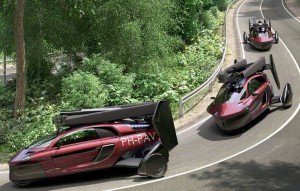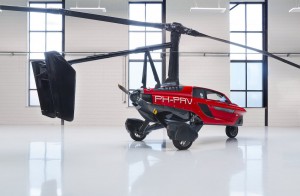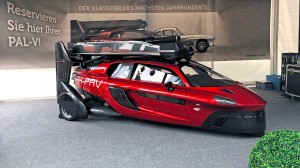A Dutch company called Pal-V said it had started taking orders for its Liberty model, a three-wheeled car which sprouts a tail-plane, a propeller and helicopter-like rotor blades when the driver wants to fly.
Before it takes off, the wings and propellers are folded up, against the bodywork so it can maneuver on city streets.
The Times of London, in its report on the Liberty, noted that entrepreneurs have long promised that flying cars are hovering just around the corner.
Two flying car manufacturers say they will deliver sky-worthy vehicles next year, to customers who place orders with them.
(Aston Martin wants to take to the air. Click Here for the story.)
Terrafugia, another flying-car maker based in New England, acquired last year by a Chinese manufacturer, has indicated that it will start taking orders this month for its Transition model, which will be delivered next year. The Transition resembles a sleek Reliant Robin with folding wings, that can fit inside a garage but is also capable of taking off from a runway.
While Pal-V says its car will cost about $600,000, Terrafugia — which named a price of $300,000 during an early stage of development — has said its vehicle will have a similar price to a luxury car.
Meanwhile, representatives of the flying car industry have been meeting to discuss financing, government regulations and progress towards better propulsion methods.
(Click Here to see more about Volvo parent Geely buys Terrafugia flying car company.)
Uber, which hopes to develop aerial cabs, recently hosted a gathering in Tokyo where it unveiled a design for an electric, vertical take-off vehicle with sound baffles to direct the noise of landing upwards. Another, held in Arkansas last month, featured representatives from Google, Terrafugia, Uber, NASA and the U.S. Air Force, according to Wired.
Talks on how flying cars might be approved by air traffic controllers are under way. This year in Washington D.C., the congressional committee on science, space and technology summoned industry chiefs to consider the problems.
“Traffic and gridlock challenges are better overcome by cars that fly rather than drive,” Lamar Smith, the committee’s chairman, declared. John-Paul Clarke, a Georgia Institute of Technology professor, warned that “surface and underground transport modes are reaching their limits,” and it was time to consider elevated routes.
(To see more about Uber’s flight plans for Aeromobil, Click Here.)
With 76,000 drones predicted to fill the UK’s skies by 2030, Barr Gazetas has created a “vertiport” that can be added to existing structures such as office blocks, car parks and even residential buildings, enabling them to land, store or recharge up to 12 passenger or cargo-carrying drones at a time.



